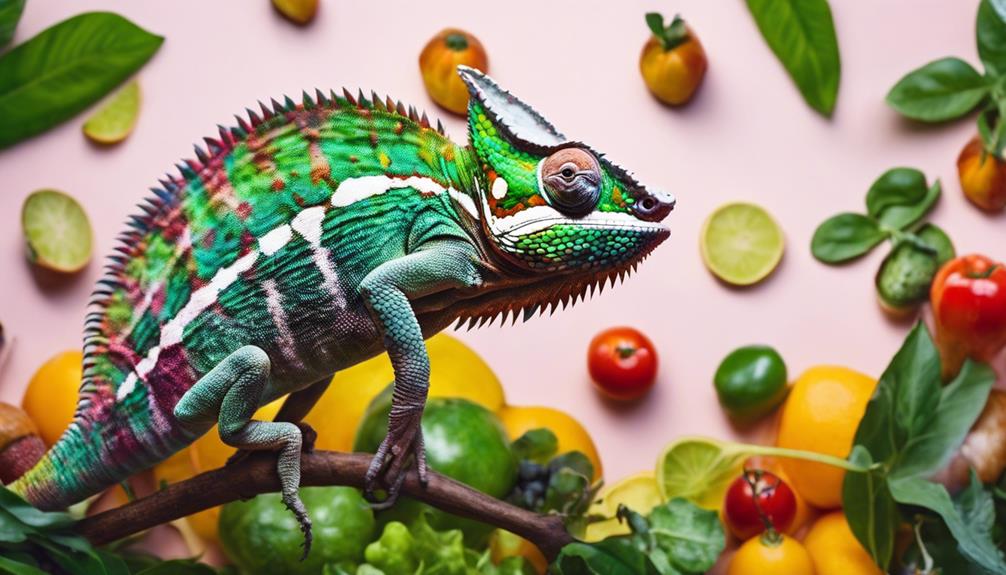Are you keen on ensuring your chameleon’s diet is top-notch for its health and vibrancy? Stay tuned to uncover the essential components that will enable you to offer your vibrant companion the nutrition it requires to thrive and shine.
Did you know that a well-balanced diet is key to your chameleon’s well-being? Let’s delve into the latest insights and research to guide you in providing the best nutrition for your colorful pet.
The best diet for a chameleon includes a variety of gut-loaded insects like crickets, roaches, flies, and worms, as well as leafy greens and vegetables. Proper hydration is also crucial, with chameleons primarily hydrating by licking water droplets from leaves and surfaces within their habitat. Regular misting and using a commercial dripper system can help maintain appropriate humidity levels for hydration.
Chameleon Dietary Requirements
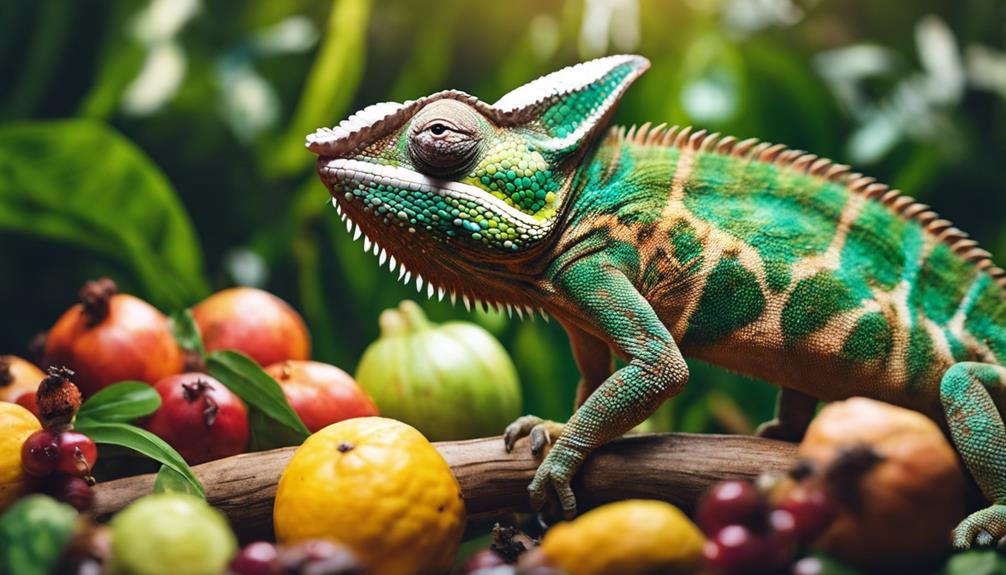
When caring for your chameleon, understanding their dietary requirements is essential.
You should be aware of the feeding frequency based on your chameleon’s age.
The variety of feeder insects needed for a balanced diet is crucial.
The importance of gut-loading for best nutrition absorption cannot be overstated.
It is necessary to supplement with calcium and multivitamins.
Proper hydration methods are crucial to guarantee their well-being.
Following these key points will help you provide your chameleon with a healthy and nutritious diet essential for their overall health and longevity.
Feeding Frequency by Age
When it comes to feeding your chameleon, the frequency varies depending on their age.
Baby chameleons require daily feeding to support their rapid growth, while juveniles should be fed once a day to meet their energy needs.
Adult chameleons, on the other hand, can be fed every other day to maintain their health and prevent overfeeding.
Baby Chameleons Feeding
To guarantee the maximum growth and development of baby chameleons, feeding them twice daily with a diet consisting mainly of small, appropriately sized insects is essential.
Make sure the insects are gut-loaded with nutritious foods to provide adequate vitamins and minerals.
Offering a varied diet from reputable sources is important for their health and well-being.
Juvenile Chameleons Feeding
For juvenile chameleons, maintaining a consistent feeding schedule is essential for supporting their growth and development. Feed them once daily, ensuring a diet rich in protein and calcium to aid in their rapid growth and bone development.
Monitor their feeding habits closely and adjust their diet as they grow to promote overall health and well-being. Proper nutrition during this stage is significant for ensuring they receive essential nutrients for healthy development.
Adult Chameleons Feeding
Feeding adult chameleons once every other day is important to maintain their health and prevent issues like obesity and nutrient imbalances.
Adult chameleons require a balanced diet with appropriate insect sizes to stay healthy. Overfeeding can lead to health problems and reduced lifespan.
It’s critical to adjust feeding schedules based on your chameleon’s appetite and activity level to guarantee their well-being and longevity.
Variety of Feeder Insects
A diverse range of feeder insects, including dubia roaches, black soldier fly larvae, superworms, crickets, and silkworms, are essential components of a chameleon’s diet to guarantee prime nutrition. These feeder insects provide a variety of essential nutrients necessary for your chameleon’s health and well-being.
Ensuring that the feeder insects are gut-loaded with nutritious foods before feeding them to your chameleon is critical. This process enhances the nutritional value of the insects, benefiting your pet’s overall health.
Offering a diverse diet of feeder insects not only helps in maintaining your chameleon’s health but also adds enrichment to its feeding routine. Remember, proper selection and care of feeder insects play a crucial role in providing your chameleon with the best possible nutrition.
Importance of Gut-Loading
How essential is the process of gut-loading for ensuring the nutritional well-being of your chameleon? Gut-loading is a critical step in providing your chameleon with essential nutrients. By feeding the feeder insects nutritious foods before offering them to your pet, you are guaranteeing that they receive a well-rounded diet. This process helps prevent any nutritional deficiencies and enhances the overall health and vitality of your chameleon. Commercial gut-loading products are available to further boost the nutritional value of the feeder insects. Check out the table below for some examples of nutritious foods you can use for gut-loading:
| Nutritious Foods for Gut-Loading | Benefits |
|---|---|
| Carrots | High in Vitamin A |
| Oranges | Vitamin C source |
| Dark leafy greens | Rich in Calcium |
| Apples | Fiber content |
| Sweet potatoes | Vitamin B6 |
Guarantee your chameleon’s diet is rich in these essential nutrients through proper gut-loading practices.
Supplementing With Calcium
Supplementing your veiled chameleon’s diet with calcium is essential for preventing metabolic bone disease and maintaining overall health. Veiled chameleons require calcium supplementation to make sure they’ve strong bones and proper physiological functions.
Dusting feeder insects with calcium powder before feeding them to your chameleon is a practical way to guarantee they receive an adequate amount of calcium in their diet. Calcium deficiency can result in deformities and various health issues in veiled chameleons, highlighting the critical role of proper supplementation.
It’s important to maintain the correct calcium-to-phosphorus ratio in supplements to support your chameleon’s well-being effectively. Regularly incorporating calcium into your chameleon’s diet regimen is key to promoting the best health and preventing potential health complications.
Hydration Methods
To guarantee peak health and well-being for your chameleon, employing effective hydration methods is paramount in meeting their dietary requirements. Chameleons primarily hydrate by licking water droplets from leaves and surfaces within their habitat.
Regular misting of their enclosure is essential to maintain appropriate humidity levels for hydration. Additionally, utilizing a commercial dripper system provides a consistent water source for your chameleon to drink from, ensuring they stay adequately hydrated.
Proper hydration is essential for preventing health issues and promoting overall well-being in chameleons. By incorporating these hydration methods into their care routine, you can help meet your chameleon’s dietary requirements and support their health and vitality.
Feeding Schedule for Chameleons

When it comes to feeding your chameleon, understanding the appropriate schedule based on their age is important for their health. Baby chameleons should be fed twice daily, juveniles once a day, and adults every other day to make sure they receive the necessary nutrients.
Following a consistent feeding routine tailored to your chameleon’s age will help support their growth and overall well-being.
Age-Based Feeding Frequency
For chameleons, the frequency of feeding should align with their age to guarantee excellent nutrition and overall well-being. Baby chameleons require feeding twice daily to support their growth and development. Juvenile chameleons should generally be fed once a day to meet their nutritional needs adequately. Adult chameleons can maintain their health by being fed once every other day, preventing overfeeding and related health issues.
Adjusting the feeding frequency based on the chameleon’s age, size, and species for the best nutrition is crucial. Consistent feeding schedules help regulate their intake and prevent obesity-related problems, ensuring that your chameleon stays healthy and thriving. Remember to provide a variety of feeder insects, gut-loaded and supplemented, along with safe fruits and vegetables for a well-rounded diet.
Importance of Feeder Insects

How do feeder insects play a pivotal role in maintaining the best health and nutrition of veiled chameleons?
Feeder insects are important for providing veiled chameleons with essential nutrients and protein necessary for their overall well-being. These insects offer a diverse range of nutrients that aren’t readily available from vegetation alone, making them a key component of a chameleon’s diet.
By gut-loading feeder insects with nutritious foods, such as fruits and vegetables, chameleons receive the best nutrition when consuming these insects. Common feeder insects like crickets, roaches, and flies are excellent sources of supplemental nutrition for chameleons. It’s essential to guarantee these insects are properly supplemented before feeding to guarantee that chameleons receive essential vitamins and minerals necessary for their health.
As a result, incorporating a variety of feeder insects and practicing proper gut-loading techniques are essential steps in maintaining the health and nutrition of veiled chameleons.
Nutritious Insect Options
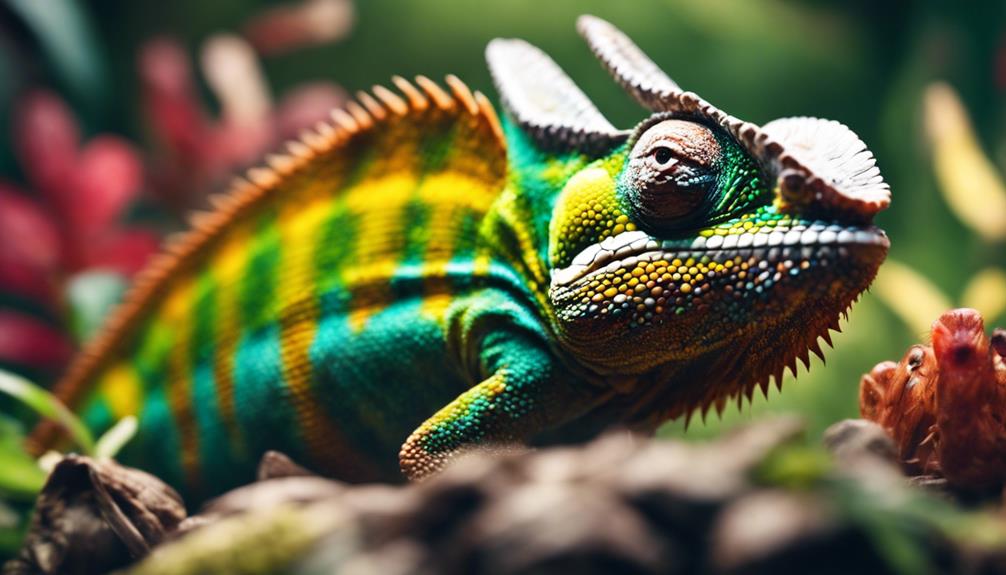
When selecting nutritious insect options for your chameleon, consider the variety of feeder insects available, each offering specific nutritional benefits. Understanding the importance of gut-loading these insects with nutritious foods will guarantee your chameleon receives a well-rounded diet.
Variety of Feeder Insects
In the domain of chameleon care, guaranteeing a varied diet of nutritious feeder insects plays a pivotal role in maintaining their health and well-being. When selecting feeder insects for your veiled chameleon, consider the following options:
- Dubia Roaches: Known for providing essential protein and nutrients crucial for your chameleon’s diet.
- Black Soldier Fly Larvae: Offering a high source of calcium and easy digestibility for peak chameleon health.
- Superworms: Rich in protein content, these insects are readily available and beneficial for your chameleon’s nutrition.
- Crickets: A staple choice for chameleons, providing a good balance of protein and fiber essential for their diet.
Including these nutritious feeder insects will help guarantee your chameleon receives a well-rounded diet to support its overall health.
Nutritional Benefits Explained
Shifting from discussing the variety of feeder insects, the nutritional benefits of these insect options for chameleons are essential for their overall health and well-being. When considering the diet of your chameleon, it’s vital to provide a balanced intake of nutrients to support their well-being. Incorporating a variety of insects into their diet can help make certain they receive the necessary vitamins, minerals, and proteins. Check out the table below for a quick overview of the nutritional benefits of some common feeder insects:
| Insect | Protein Content | Calcium Content | Nutritional Highlights |
|---|---|---|---|
| Crickets | High | Moderate | Rich in protein and essential nutrients |
| Dubia Roaches | High | High | Nutritious alternative with protein and calcium |
| Black Soldier Fly Larvae | High | High | Calcium-rich and low in fat |
| Superworms | High | Moderate | Good protein source for varied diet |
| Silkworms | Moderate | Moderate | Provides protein and essential nutrients |
Incorporating these insects, along with a balanced diet of leafy greens and appropriate vitamin and mineral supplements, can help make certain your chameleon’s diet supports healthy growth and calcium absorption.
Importance of Gut-Loading
To enhance the nutritional value of your chameleons, it’s essential to understand the importance of gut-loading nutritious insect options. Gut-loading insects involves feeding them highly nutritious foods like dark leafy greens, fruits, and commercial gut-loading products. This process guarantees that chameleons receive essential vitamins, minerals, and nutrients from their prey, helping prevent nutritional deficiencies.
Source Feeder Insects Safely
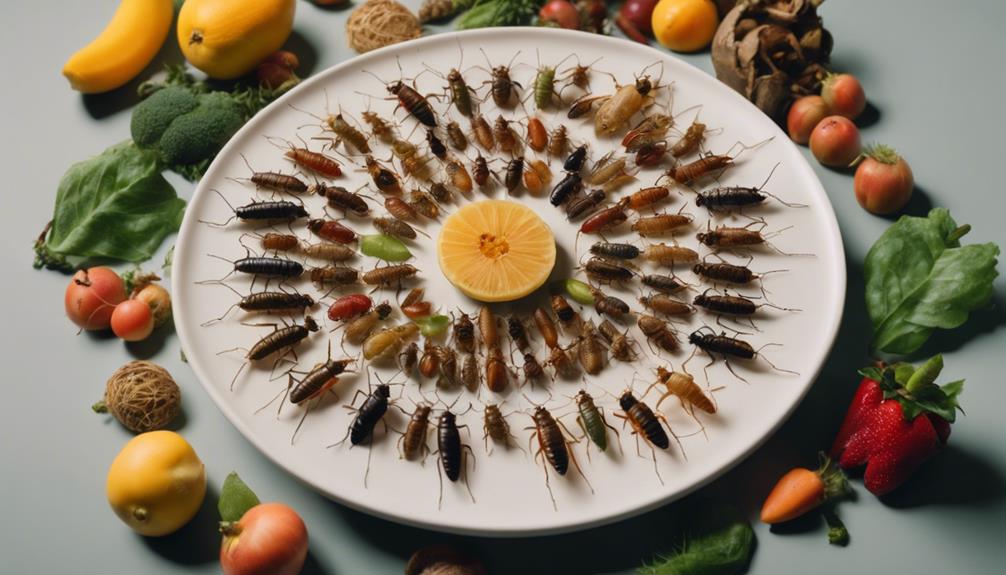
When sourcing feeder insects for your veiled chameleon’s diet, it’s important to purchase them from reputable suppliers to make sure they’re safe and free from diseases or parasites. Opting for commercially bred feeder insects over wild-caught bugs can greatly reduce the risk of harmful pathogens affecting your chameleon’s health.
Make sure that the feeder insects you choose are gut-loaded to provide essential nutrients and vitamins important for your chameleon’s diet. When handling feeder insects, maintain proper hygiene and sanitation practices to prevent any contamination that could harm your pet.
Enhancing Insect Nutrition
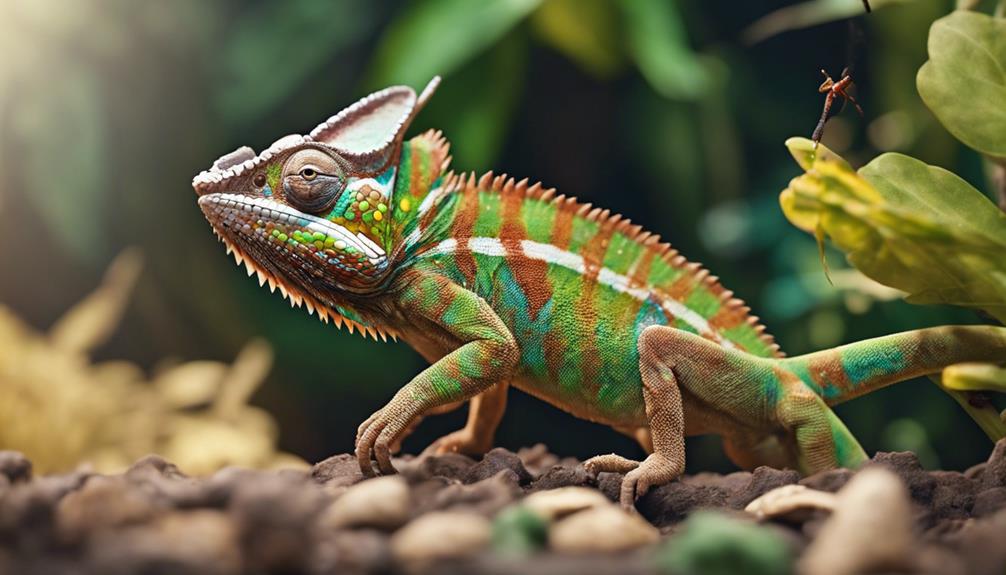
To elevate the nutritional quality of feeder insects for your chameleon’s diet, enhancing their nutrient content through gut-loading with a variety of nutritious foods is imperative for maintaining your pet’s health and well-being. By feeding the insects a diverse diet that includes items such as fresh fruits, vegetables, and high-quality commercial gut-loading products, you guarantee that the chameleons receive a broad spectrum of essential nutrients.
Offering a variety of insects like Dubia roaches, black soldier fly larvae, and super worms not only adds diversity to their diet but also secures them receive a range of nutrients critical for their health. Dusting these insects with calcium and other essential supplements before feeding them to your chameleon further boosts their overall nutrition intake.
Regularly monitoring and removing any uneaten insects from the enclosure helps maintain a healthy feeding routine and prevents any potential health issues for your chameleon.
Essential Supplements for Chameleons
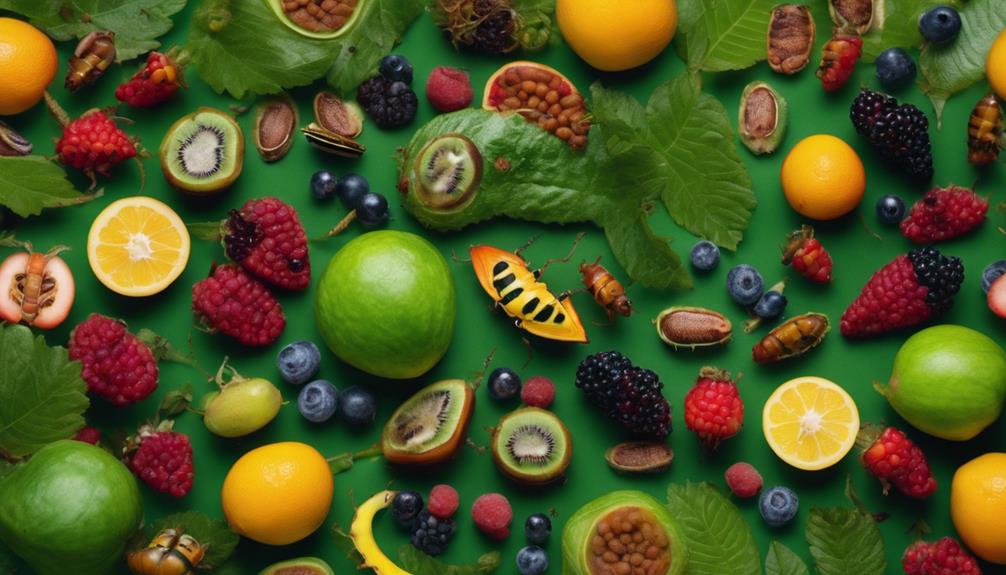
Ensuring proper supplementation with essential nutrients is important for maintaining the health and well-being of chameleons. Calcium supplements play a crucial role in preventing metabolic bone disease, while vitamin A supplements help maintain proper eye health and immune function.
Multivitamin dusting is essential for providing chameleons with a well-rounded source of nutrients necessary for their overall health. When selecting supplements, it’s important to choose ones with the correct calcium-to-phosphorus ratio to support chameleon well-being effectively.
Additionally, reading supplement labels carefully to determine the appropriate dosage is paramount in ensuring your chameleon receives the right amount of essential nutrients. By incorporating calcium supplements, vitamin A supplements, and multivitamin dusting into your chameleon’s diet regimen with the correct ratios and dosages, you can significantly contribute to their health and longevity.
Safe Fruits and Vegetables
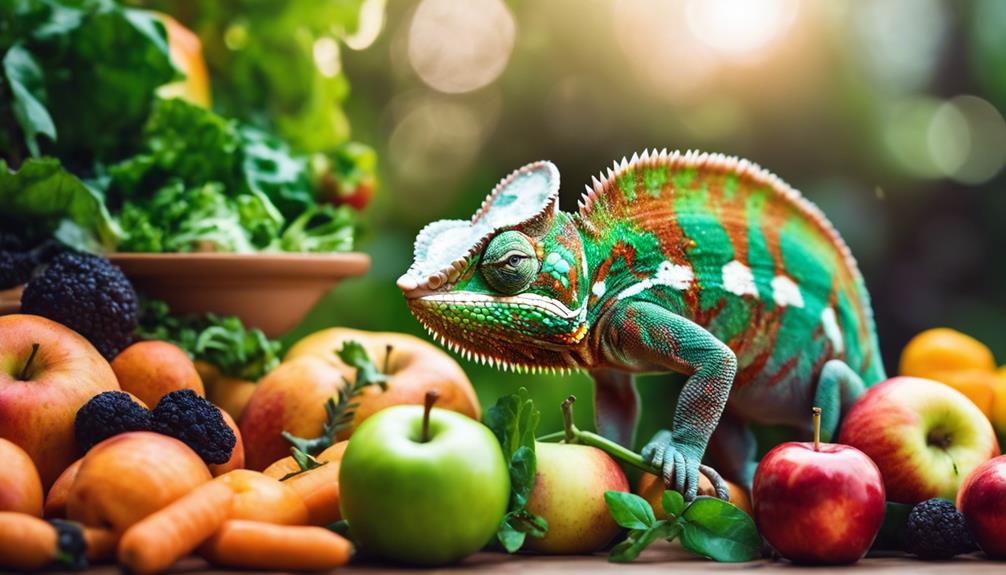
When considering safe fruits and vegetables for your chameleon, focus on nutrient-rich greens like collard greens, dandelion greens, and arugula.
Hydrating fruit options such as apples, berries, and mangoes can provide added nutrition to their diet.
Including a variety of these safe options guarantees dietary diversity and peak nutrition for your chameleon’s well-being.
Nutrient-Rich Greens
Including nutrient-rich greens like collard greens, dandelion greens, and arugula in your veiled chameleon’s diet is essential for providing crucial vitamins and minerals. To guarantee peak health and well-being for your pet, consider incorporating these nutrient-rich greens:
- Collard Greens: Rich in calcium and vitamin A, crucial for bone health and vision.
- Dandelion Greens: Packed with antioxidants and fiber, aiding digestion and boosting immunity.
- Arugula: High in vitamin C and K, promoting skin health and blood clotting.
- Carrots: Offering beta carotene and fiber, supporting eye health and digestion.
Hydrating Fruits Options
How can you guarantee your chameleon stays hydrated with safe and beneficial fruits and vegetables in its diet? To make sure your chameleon maintains proper hydration levels and receives essential nutrients, incorporating hydrating fruits into its diet is key.
Consider offering the following safe and hydrating fruit options:
- Cucumbers: High in water content, cucumbers provide essential hydration for your chameleon.
- Strawberries: These fruits offer a combination of water and important vitamins to support your chameleon’s health.
- Watermelon: A hydrating fruit option that can help prevent dehydration in chameleons.
- Blueberries: Safe and hydrating, blueberries also provide antioxidants to boost your chameleon’s well-being.
Hydration for Chameleons
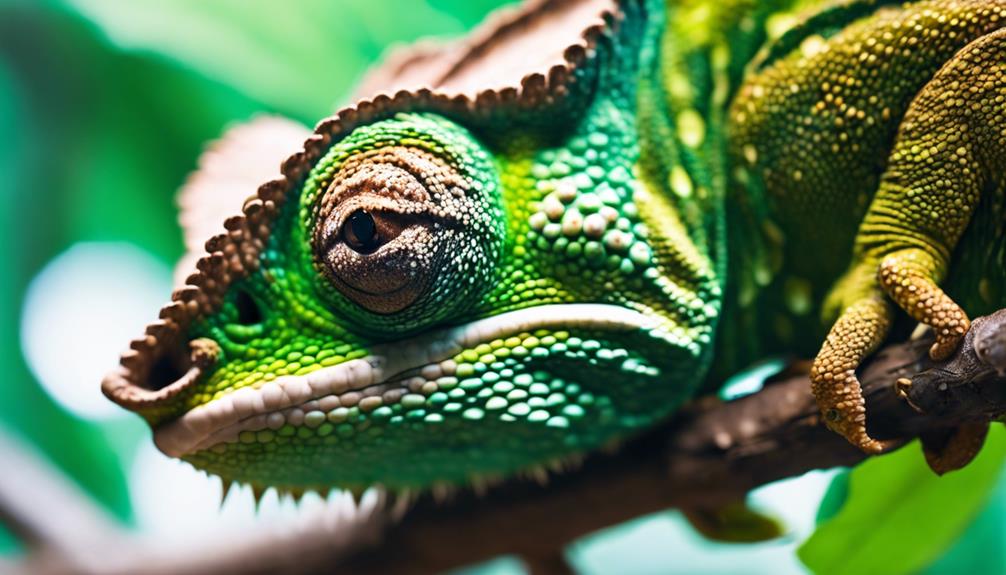
Proper hydration is essential for maintaining the health and well-being of chameleons, as they rely on licking water droplets for their water intake. To guarantee your chameleon stays hydrated, mist their habitat a couple of times per day. This method allows them to drink water droplets, mimicking how they’d hydrate in the wild.
Using a commercial dripper for water can also provide a consistent water source for your chameleon. Since chameleons may not drink from standing water sources, misting their enclosure is important for their hydration needs.
Monitoring their hydration levels and adjusting care accordingly is crucial for their overall health. Remember, proper hydration not only prevents health issues but also plays a significant role in maintaining your chameleon’s well-being. Make sure to incorporate misting into your daily care routine to keep your chameleon healthy and happy.
Maintaining Chameleon Well-being

Are you aware of the key factors that contribute to maintaining your chameleon’s well-being?
Feeding your chameleon a balanced diet is critical for its health. Offer small crickets and greens like mustard daily to make sure they receive proper nutrition. The insect diet should be varied, including Dubia roaches, black soldier fly larvae, superworms, and silkworms. Adjust feeding schedules based on age, with babies needing two meals a day, juveniles once daily, and adults every other day. It’s important to source insects from reliable suppliers to avoid potential health issues. Additionally, gut-load insects with nutritious foods, provide supplements like calcium and multivitamins and offer safe fruits and vegetables.
Proper hydration is also crucial; make sure your chameleon has access to dripping water sources or mist their habitat regularly. Monitoring hydration levels closely and providing a water bowl in their enclosure are essential for their overall well-being and health maintenance.
Frequently Asked Questions
What Is a Good Diet for Chameleons?
For chameleons, a good diet includes gut-loaded insects like crickets, roaches, flies, and worms, mimicking their natural food. Leafy greens and vegetables supplement their nutrition. Proper hydration is crucial; they drink water droplets from misting or a dripper system.
How Much Should a Chameleon Eat a Day?
You should feed your chameleon based on its age; babies need two meals daily, juveniles once a day, and adults every other day. Watch for hunger cues and adjust accordingly. Offer a variety of insects and gut-loaded fruits/veggies for best health.
What Should You Not Feed a Chameleon?
Avoid feeding chameleons toxic plants, high-oxalate veggies, and fruits high in citric acid. Steer clear of wild-caught or chemically exposed insects to prevent health issues. Stick to safe, nutritious options for their well-being.
What Fruit and Vegetables Can a Chameleon Eat?
You can feed your chameleon a variety of fruits like mangoes, apples, and berries for added nutrients. Leafy greens such as collard greens, mustard greens, and dandelion greens are excellent vegetable options. Carrots and arugula are safe choices too.
Conclusion
Promote your chameleon’s health and happiness by following this detailed chameleon diet guide.
By incorporating a variety of nutritious insects, supplements, and fruits and vegetables, you can provide a well-rounded diet that meets their specific needs.
Remember to source feeder insects from trusted suppliers and maintain proper hydration to keep your chameleon thriving.
With dedication and attention to detail, you can promote your chameleon’s well-being and watch them flourish with a balanced and nourishing diet.
